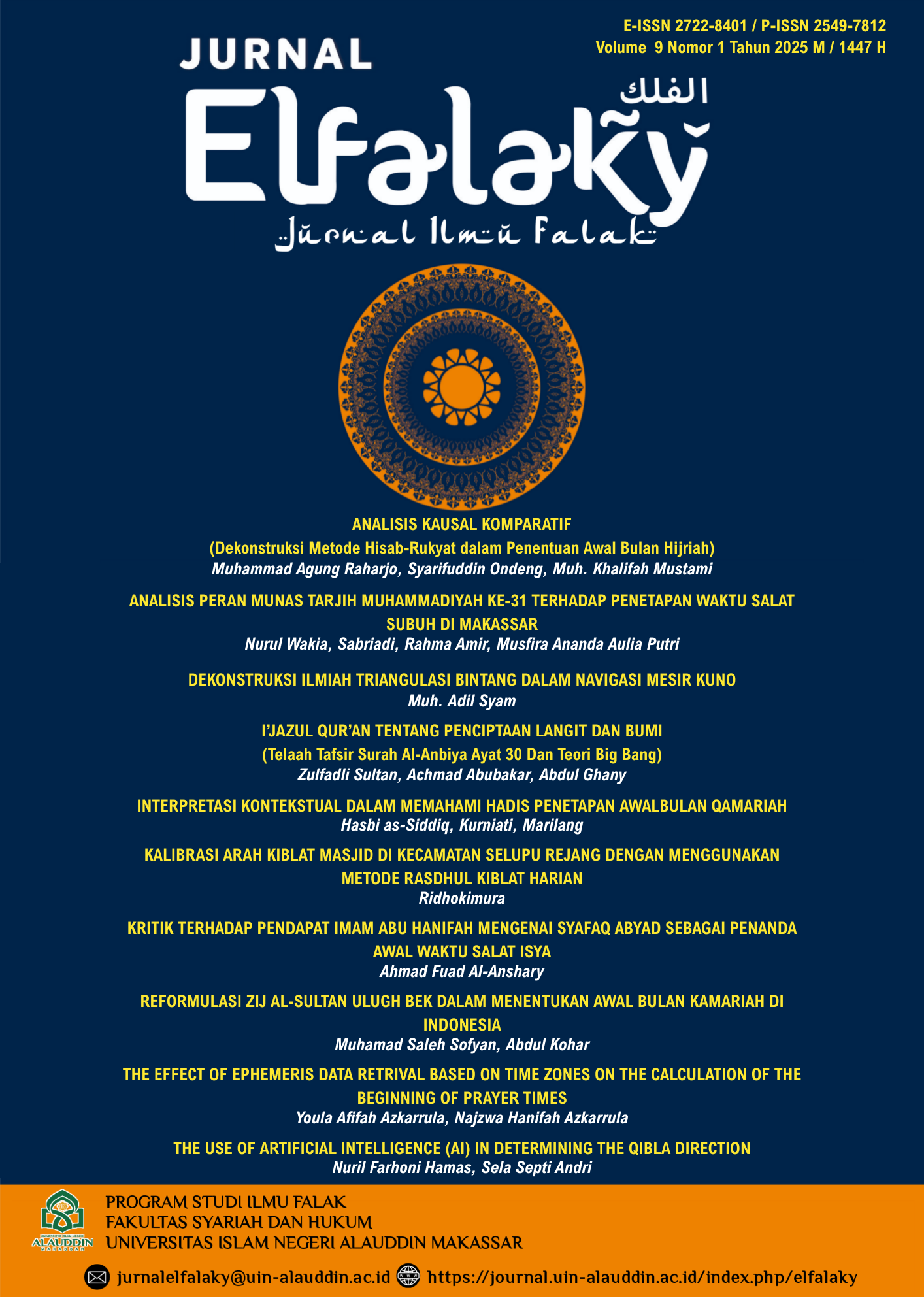KRITIK TERHADAP PENDAPAT IMAM ABU HANIFAH MENGENAI SYAFAQ ABYAD SEBAGAI PENANDA AWAL WAKTU SALAT ISYA
DOI:
https://doi.org/10.24252/ifk.v9i1.53869Keywords:
syaafaq abyad, Imam Abu Hanifah, Beginning of Isha’ Prayer TimeAbstract
This study discusses the initial debate on the time of Isha prayer among scholars,
which mainly involves differences of opinion between Imam Malik, Imam Syafi'i,
and Imam Abu Hanifah. Imam Malik and Imam Syafi'i agreed that the time of Isha
prayer begins with the disappearance of the red light (ash-Syafaq al-Ahmar) after
sunset, while Imam Abu Hanifah argued that the time is marked by the
disappearance of the white light (syafaq abyad). This difference arises from various
interpretations of the word "syafaq" in Arabic which has multiple meanings. This
study examines the social, cultural, and scientific contexts during the time of Imam
Hanafi and the influence of the development of astronomy on determining prayer
times. This article also analyzes the influence of geographical and climatic factors,
showing that syafaq abyad is easier to observe in Baghdad compared to Indonesia.
In Baghdad, the dry atmospheric conditions and minimal light pollution provide a
sharper contrast, while in Indonesia, high humidity and light pollution make it
difficult to observe the phenomenon. Furthermore, criticism of Imam Hanafi's
opinion is expressed by considering a multi-disciplinary approach, including
theology and astronomy, indicating the need for a more flexible and adaptive
understanding in determining prayer times in various geographical contexts. The
conclusion of this article shows the importance of integrating tradition with
scientific advances to achieve more accurate and relevant worship practices in the
modern era, reinforcing the need for open discussion among scholars, and
increasing harmony in worship practices among Muslims throughout the world.
References
Ahmad, S. 2014. "Using Geographic Information Systems to Calculate Prayer Times." Journal of Geographic Sciences 5 (2): 112-125.
Al-Ghazali, M. 2005. "Islamic Science: A Historical Perspective." Journal of Islamic History 8 (2): 55-70.
Ali, A. 2017. "Mathematical Approaches to Islamic Timekeeping." International Journal of Islamic Finance 5 (3): 45-60.
Ali, R. 2020. "The Importance of Accurate Prayer Time Calculations." Journal of Islamic Ethics 14 (2): 101-115.
Badran, H. 2014. "A Method for Calculating Islamic Prayer Times." Journal of Islamic Research 9 (1): 77-89.
Bukhari, H. 2018. "Astronomical Calculations in Different Geographical Locations." Journal of Islamic Astronomy and Geography 11 (1): 33-48.
Chernin, A. D. 2012. "Twilight and Its Implications for Astronomical Observations." Journal of the Optical Society of America 29 (4): 650-654.
Farhan, A. 2021. "Islamic Jurisprudence in the Modern Age: A Study." Journal of Islamic Law and Society 9 (1): 88-102.
Farooq, A. 2022. "Islamic Prayer Timing: A Mathematical Approach." Journal of Islamic Mathematics 4 (2): 77-88.
Green, R. 2011. "The Color of Twilight: An Astronomical Perspective." Astrophysical Journal 738 (1): 1-10.
Hossain, M. 2013. "Practical Applications of Astronomical Calculations in Islamic Practices." Journal of Islamic Science 15 (2): 150-162.
Hussain, M. 2015. "Astronomical Methods for Determining Islamic Prayer Times." Journal of Islamic Law 8 (2): 101-115.
Kaltcheva, N. 2013. "Understanding Twilight: The Role of Atmospheric Scattering." Atmospheric Research 127: 98-110.
Kauffman, L. 2015. "The Science of Twilight: A Study of Light and Atmosphere." Journal of Atmospheric Sciences 12 (3): 99-110.
Kaur, R., and Singh, B. 2016. "Impact of Atmospheric Conditions on Twilight Phenomena." International Journal of Astronomy and Astrophysics 6 (2): 135-142.
Kavanagh, J. 2015. "Astronomical Twilight: A Comprehensive Analysis." Journal of Astronomical Sciences 62 (4): 305-317.
Khan, F. 2020. "Astrophysical Calculations for Islamic Prayer Times." Journal of Astronomy Education 9 (1): 45-56.
Khan, J. 2017. "Fikih dan Astronomi: Mencari Titik Temu." Journal of Islamic Law and Astronomy 6 (3): 45-59.
Khan, M. 2019. "The Role of Modern Astronomy in Islamic Practices." Journal of Astronomy and Astrophysics 10 (2): 55-70.
Nasr, S. H. 1996. Islamic Philosophy from Its Origin to the Present: Philosophy in the Land of Prophecy. State University of New York Press.
Nasr, S. H. 2002. Science and Civilization in Islam. Islamic Book Trust.
Rahim, A. 2020. "Astronomical Calculations of Islamic Prayer Times." Journal of Islamic Studies and Culture 8 (1): 11-25.
Rahim, F. 2018. "Integrating Modern Science into Islamic Practices." Journal of Islamic Philosophy 8 (1): 77-90.
Rahman, A. 2015. "The Role of Latitude and Longitude in Islamic Timekeeping." Journal of Islamic Geography 3 (1): 22-35.
Rahman, F. 2002. "Islam and Science: Religious Orthodoxy and the Battle for the Soul of Islam." Journal of Islamic Studies 13 (1): 1-20.
Rahman, F. 2009. "Islamic Jurisprudence: An Introduction." Journal of Islamic Law and Culture 11 (1): 45-67.
Rahman, M. 2018. "Mathematical Models in Islamic Astronomy." Journal of Islamic Science and Technology 14 (1): 25-39.
Rinto Anugraha, dalam artikel yang ditulis, Cara Menghitung Waktu Salat, yang diakses di www.eramuslim.com pada tanggal 13 November 2024
Sadiq, R. 2019. "The Future of Islamic Timekeeping: Challenges and Opportunities." Journal of Islamic Studies 12 (2): 33-50.
Sulaiman, S. 2019. "Mathematical Models for Islamic Prayer Time Calculations." Journal of Mathematics and Islamic Studies 6 (1): 33-47.
Zain, M. 2018. "The Use of Technology in Determining Prayer Times." Journal of Islamic Technology 7 (4): 89-101.









